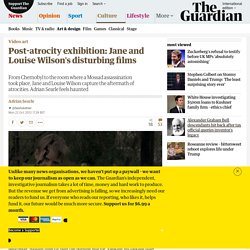

Post-atrocity exhibition: Jane and Louise Wilson's disturbing films. Reading this on mobile?

Click here to view On 29 April 1986, three days after Reactor Unit 4 at the Chernobyl nuclear power station went into meltdown and exploded, Vladimir Shevchenko gained access to the site and filmed the ongoing disaster. He shot some of his film from a helicopter, passing directly over the burning reactor. Viewing his footage later, Shevchenko discovered that portions of it were seriously degraded. At first he thought the film stock was faulty; it turned out that the aberrant flashes and blips, and the static on the soundtrack, were the invisible crackles of radiation itself, made visible on the photographic emulsion. Shevchenko, along with the film and the 35mm Konvas Avtomat camera he used, had all been irradiated. The Toxic Camera features interviews with Shevchenko's surviving colleagues, as well as a great deal of atmospheric and sometimes moving incident. The Wilsons' work is more than just a film. . … we have a small favour to ask. Wiltshire's Secret Underground City: The Burlington Nuclear Bunker located in Corsham, United Kingdom.
In disaster movies, when the asteroid is hurtling towards earth, or the super volcano is about to blow, there is always a top-secret location where the president, government officials and top-scientists are whisked away to.

Only big enough to support the most important humans, it is usually some sort of mountain, cave, or subterranean bunker made to support a few thousand folks for long enough for the radiation/dust/fire to clear. In England, it just so happens that that location is real and located under a charming sleepy market town known as Corsham, Wiltshire. One hundred feet below the manors, churches and cobblestone streets is a 35-acre subterranean “Cold War City.”
The reason this particular location was chosen for the bunker was its already-extensive system of limestone caves running under the city. The bunker had a secret rail line coming off the main London-to-Bristol railway, so that the English royalty might escape to the underground city. The National Heritage List for England. List entry Summary This building is listed under the Planning (Listed Buildings and Conservation Areas) Act 1990 as amended for its special architectural or historic interest.

Name: Brandsby Royal Observer Corps monitoring post List entry Number: 1407168 Location Sited at SE 5728772045, immediately north of the driveway to Zion Hill Farm, Crayke, York, YO61 4TT The building may lie within the boundary of more than one authority. National Park: Not applicable to this List entry. Grade: II Date first listed: 10-Apr-2012 Date of most recent amendment: Not applicable to this List entry.
Asset Groupings This list entry does not comprise part of an Asset Grouping. List entry Description Summary of Building Royal Observer Corps (ROC) monitoring post, 1964. Reasons for Designation History. Peter Duggan's Artoons: Cultural cold war. News.bbc.co.uk/1/shared/bsp/hi/pdfs/03_10_08nuclearattack.pdf. What Lies Beneath. In pictures: Britain's secret nuclear bunkers. Saved for the nation: monuments to Britain's cold war. A hardened aircraft shelter at RAF Upper Heyford, near Bicester, in Oxfordshire.

Photograph: English Heritage Some of the most sinister historic monuments in Britain, a set of hardened concrete bunkers built to shelter American nuclear bombers, are to be protected and preserved, it has been announced. A planning inquiry into the future development of Upper Heyford, near Bicester, has accepted the English Heritage argument that the site is one of the best preserved Cold War landscapes in Britain.
The government has now agreed that the heart of the complex, which is on the Schedule of Monuments with sites such as Stonehenge, should be protected from development. Andy Brown, regional director of English Heritage, who gave evidence at the enquiry, said: "The decision to safeguard these structures brings England's cold war heritage into the mainstream, alongside the Georgian and Victorian buildings that people more often think of as our architectural heritage.